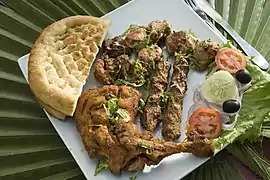Khichdi
Khichdi or Khichuṛī (pronounced [ˈkʰɪtʃɽi]) is a dish in South Asian cuisine made of rice and lentils (dal), but other variations include bajra and mung dal kichri. In Indian culture, in several regions, especially in the northern areas, it is considered one of the first solid foods that babies eat.[1] Hindus, mainly from north/northwest, who avoid eating grains during fasting, eat Sabudana Khichadi made from sago.[2][3] In the southern part of India, however, the word Kichri is not that popular. While people of Tamil Nadu and Andhra regions cook Pongal, and Kannadigas prepare Bisi bele bhath, Keralites have no similar dish. Kichri is a salty porridge. Dalia is another similar sweet porridge made from the crushed wheat or barley mixed with sugar and milk.[4]
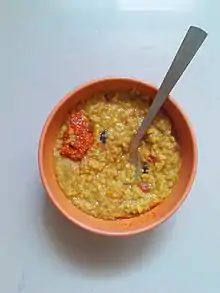 A bowl of dal khichdi served with achaar | |
| Alternative names | Khichri, khichadi, khichdee, khichadi, khichuri (Bengali), khisiri (Assamese), khechidi/khechudi (Odia), kisuri (Sylheti), khichari, kitcheree, kitchree |
|---|---|
| Region or state | Indian Subcontinent |
| Associated national cuisine | India, Bangladesh, Pakistan, Nepal |
| Main ingredients | Rice, lentils, spices |
| Variations | Moong dal khichri, bajra-ri-khichri (Rajasthani millet khichri), sadi khichri (lentil and rice khichri) |
Khichdi was the inspiration for the Anglo-Indian dish kedgeree.[5]
Etymology and spelling
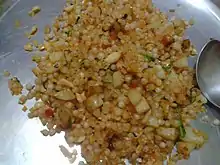
The term khichdi (Khicṛī) is derived from Sanskrit खिच्चा khiccā, a dish of rice and legumes.[6][7]
Some divergence of transliteration may be noted in the third consonant in the word khicṛī. The sound is the retroflex flap [ɽ], which is written in Hindi with the Devanagari letter ⟨ड़⟩, and in Urdu script with the Perso-Arabic letter ⟨ڑ⟩. In Hindustani phonology, the etymological origin of the retroflex flap was /ɖ/ when it occurred between vowels.[8] Hence in Devanagari the letter ⟨ड⟩, representing /ɖ/, was adapted to write /ɽ/ by adding a diacritic under it. In Urdu script, the phonological quality of the flap was represented by adapting the letter ⟨ر⟩, representing /r/, with a diacritic added above it to indicate the retroflex quality. The occurrence of this consonant in the word khicṛī has given rise to two alternative spellings in English: khichdi, which reflects its etymology, and khichri, which reflects its phonology.
History
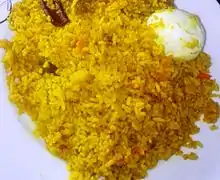
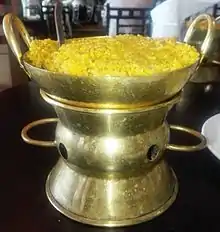
The Greek king Seleucus during his campaign in India (305-303 BC), mentioned that rice with pulses is very popular among people of the Indian subcontinent.[9] Strabo also notes that Indian food mainly consisted of rice porridge and a beverage made of rice, presently called Arak.[10] The Moroccan traveller Ibn Battuta mentions kishri as a dish in India composed of rice and mung beans, during his stay around 1350.[11] Khichdi is described in the writings of Afanasiy Nikitin, a Russian adventurer who travelled to the Indian subcontinent in the 15th century. It was very popular with the Mughals, especially Jahangir. Ain-i-Akbari, a 16th-century document, written by Mughal Emperor Akbar's vizier, Abu'l-Fazl ibn Mubarak, mentions the recipe for khichdi, which gives seven variations.[12] There is an anecdotal story featuring Akbar, Birbal and khichdi.[13]
The Anglo-Indian dish Kedgeree is thought to derive from khichri.[5][14]
Regional variations
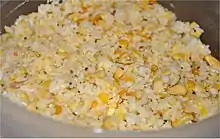
Khichdi is a very popular dish across the Indian subcontinent, including in Bangladesh, Nepal and Pakistan also. The dish is widely prepared in many Indian states, such as Haryana, Rajasthan, Gujarat, Tamilnadu, West Bengal, Assam, Bihar, Jharkhand, Uttar Pradesh, Odisha, and Maharashtra.[15] Vegetables such as cauliflower, potato, and green peas are commonly added. A popular variant in coastal Maharashtra is made with prawns. Khichdi is also a favourite comfort food, owing to the convenience of being able to cook the dish in a single simmering pot.
In other regions, khichdi is commonly served with a side of kadhi, and often accompanied with papadum.
Bengal
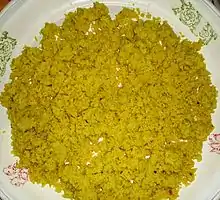
In Bengal, the dish is known as খিচুড়ি , Khichuri, Sylheti: ꠈꠤꠌꠥꠞꠤ kisuri, and is considered a rich gourmet delicacy. Often seasoned with ghee (clarified butter) and acar (oil-based pickle), it is accompanied with meat curries, fish, potato chops, aubergine, different types of pickles and omelettes. The rice is commonly cooked and served on rainy days. It is a staple for holy ceremonies and as an offering to gods.
Cooks and homemakers often prepare this dish with many ingredients mixed with it. That is one of the reasons the idiom joga khichuri (জগা খিচুুড়ি) is used in Bangla to mean "a mess".
A stickier version of the rice is traditionally served to children and sick people. It is the first solid to which babies are introduced. Rice and lentils are simmered till mushy, seasoned with turmeric and salt, and fed to infants to introduce them to "adult" food. The elderly and sick, especially those having stomach problems, are served with the rice as it is easily digestible compared to other dishes which involve more meat and spices.
One popular preparation in Bangladesh is with fatty pieces of beef, where the fat of the beef is used in place of beef and chunks of beef are scattered throughout the dish.
During Ramadan, Muslims in the city of Sylhet in Bangladesh, and Sylheti diaspora in countries such as the United Kingdom and United States break their fast with kisuri, and it is a notable delicacy to eat during the holy month by the Sylheti people.
Bihar
Khichdi is also very popular in Bihar. It is made with rice, dal, and garam masala, cooked into a semipaste like consistency and eaten with ghee, baigan ka bharta, aaloo ka bharta (mashed potato with onions, green chilli, salt, and mustard oil), tomato chutney (blanched tomato, onion, green chilli, grated ginger and mustard oil), pāpaṛ, tilori (a fried snack), and mango pickle. It is customarily eaten every Saturday in Bihar, and also at dinner during Makar Sankranti. A popular variation in khichdi in winter is the addition of cauliflower and green peas.
Gujarat
Khichdi is a very popular dish of Gujarat. It is served with special kadhi and addon dishes such as Surati undhia and ringan no oro.
Khichdi is also served in various flavor such as Sadi Khichdi, Masala Khichdi, Swaminarayan Khichdi etc.
In particular, it is a staple food (and daily diet) for most of the agrarian communities such as Patels.
In Bharuch district, Gujarat, khichdi Is historically green, however in rare instances the rice and mung dal is cooked with turmeric to make it yellow, served mixed with kadhi, a thin soup made from gram flour and curd, curry leaves, cumin, and mustard seeds, and eaten as an evening meal.
Khichari is the traditional diet and a daily meal of Kutchi people, and they make several varieties of dishes using khichari. Khichdi, when well cooked with a little oil, is considered a light and nutritious dish, and is especially popular amongst many who follow an ayurvedic diet or natural cure.
Haryana
Kichadi is a popular traditional staple in Haryana, specially in the rural areas. Haryanvi kichri is made from pearl millet and mung dal (split mung bean) pounded in mortar (unkhal), and often eaten by mixing with warm ghee or lassi, or even yogurt.[16][17][18][4] Sometimes, jowar is also mixed with bajra and mung dal.[4]Kichri is salty and dalia is another similar sweet porridge made from the crushed wheat or barley mixed with sugar and milk.[4]
Odisha
Khechidi is very popular in Odisha. The varieties of khechidi in Odisha include adahengu khechidi (ginger-asafoetida khichdi), moong dal khichdi, etc. Adahengu khechidi is a popular dish in the Jagannath Temple, as well. At home, moong dal khechidi and other khechidis are served with pampad, pickle, curd, aaloo bharta, or baigan bharta, raita, dalma, and chutney. In Kendujhar, a northern district of Odisha, a type of green colored khichdi is made with whole black moong which is indigenous to the Baldevjiu Temple and people of the district.
South India
Khichdi is called Huggi in Karnataka and is very popular as a breakfast. It's distant variant Bisi bele bath ("hot lentil rice") is also famous and served during lunch. It is called Pongali in the states of Telangana and Andhra Pradesh, and Pongal in Tamil Nadu and Kerala. The South Indian variety follows a different recipe giving it a slightly different taste. The lentils are first roasted in ghee, before cooking with rice. The seasonings used are also different.
Hyderabadi Muslims
The Hyderabadi Muslim community, of the erstwhile Hyderabad State, in present-day Telangana, Marathwada, and Hyderabad-Karnataka regions, make khichdi as a common breakfast dish, and is an important part of Hyderabadi cuisine.[19] The dish is called khichdi, kheema, khatta, or other switch-around versions of the previous, named after the three parts of the meal,kKhichdi, ground beef, and a sour sauce, made of tamarind and sesame.[20] The dish is commonly eaten with an omelet, as well.
Pakistan
In Pakistan, khichri (Urdu: کھچڑی) is prepared with rice and pulses or lentils and has salt as condiment. It could also have baghaar, where fried onion is added to it. Khichri is popular food for babies between 4 and 6 months when they start eating solid food, since it is soft and has no spices. People with an upset stomach also prefer khichri since it has no spices.
Fiji Islands
Khichri is a common and easy-to-prepare meal enjoyed in the Indian and also extending to growing numbers of Fijian communities. It is prepared by frying rice, lentils, masala, salt, onions, garlic, and often cubes of potatoes and ghee, and then adding water to boil it until cooked. It is consumed on its own or sometimes with pickles and chutney. The term khichri is referred to in a figure of speech common in the Indian communities "birbal ke khicri kab pakegi" (translated as "how long will it take to cook the khichri?"). This a reference to a folk tale where Birbal in a battle of wits with King Akbar, was challenged to cook khichri in a pot which was placed 20 m above the flame, so as to illustrate the amount of time it would take for someone to "complete a task".
Khichra and khichdi
Khichra is similar to haleem, a meat dish, while khichdi is a vegetarian dish with rice and pulses or lentils, with no spices.
National dish controversy
In 2017, Indian media unofficially designated it as the "national dish", as it is being globally promoted by the government of India as "queen of all foods". The report that the government may designate khichadi as India's "national dish" brought significant ridicule from the opposition politicians.[21]
However, India's Minister of Food Processing Industries Mrs. Harsimrat Kaur Badal clarified that while Khichdi is considered nutritious and healthy food in India, the government did not have any plans to designate a national food.[22][23][24]
In popular culture
Khichdi has lent its name to media synonymous with ensembles or potpourri as depicted in the popular culture through movies such as Khichdi: The Movie, and TV sitcoms such as Khichdi (franchise), Khichdi (TV series), and Instant Khichdi.
See also
| Wikimedia Commons has media related to Khichdi. |
- Congee, a type of rice porridge eaten in many Asian countries
References
- Hetal of MasterChef U.S. season 6
- Sean Williams, 2015, "The Ethnomusicologists' Cookbook, Volume II: Complete Meals from around the world", Routledge Taylor & Francis group, page 37.
- Uma Aggarwal, 2009, "The Exquisite World of Indian Cuisine", Allied Publications, page 106.
- Charmaine O' Brien, 2013, "The Penguin Food Guide to India", Penguin Books Penguin Books.
- Lobscouse and Spotted Dog; Which It's a Gastronomic Companion to the Aubrey/Maturin Novels, Anne Chotzinoff Grossman and Lisa Grossman Thomas, Norton, 1997, p. 12. ISBN 978-0-393-32094-7
- Monier-Williams, Monier (1995). A Sanskrit-English Dictionary. Delhi: Motilal Banarsidass. p. 339. ISBN 81-208-0065-6. Retrieved 29 June 2010.
- R. S. McGregor, ed. (1997). The Oxford Hindi-English Dictionary. Oxford University Press. p. 237. ISBN 978-0-19-864339-5.
- Masica, Colin P. (1991). The Indo-Aryan Languages. Cambridge University Press. pp. 97–98. ISBN 0-521-23420-4. Retrieved 29 June 2010.
- "Khichdi–A Comfort Food – India Currents". Archived from the original on 16 February 2013. Retrieved 1 January 2015.
- Reddy, Anjana (2016). "Archaeology of Indo-Gulf Relations in the Early Historic Period: The Ceramic Evidence". In Himanshu Prabha Ray (ed.). Bridging the Gulf: Maritime Cultural Heritage of the Western Indian Ocean. New Delhi: Manohar Publishers. p. 68. ISBN 978-93-5098-143-6.
- "Rehla of Ibn Battuta". Retrieved 21 March 2015.
- Recipes for Dishes Archived 2011-07-27 at the Wayback Machine Ain-i-Akbari, by Abu'l-Fazl ibn Mubarak. English tr. by Heinrich Blochmann and Colonel Henry Sullivan Jarrett, 1873–1907. The Asiatic Society of Bengal, Calcutta, Volume I, Chapter 24, page 59. "3. K'hichri. Rice, split dal, and ghee 5 s. of each; ⅓ s. salt: this gives seven dishes."
- "Cooking The Khichdi is one of Birbal Stories". Retrieved 1 January 2015.
- Smith, Delia. "Buttery Kedgeree". Delia Smith's Complete Cookery Course. Retrieved 10 March 2008.
- Chatterjee, Priyadarshini (10 February 2017). "From Kashmir to Karnataka, khichdi is the one true underestimated food of India". Scroll.in. Retrieved 10 February 2017.
- 1990, "Haryana District Gazetteers: Sonipat", Government of Haryana publication, Page 83.
- 1912, "Haryana District Gazetteers: Delhi district gazetteer", Government of India Gazetteers Organisation, Page 90.
- 1987, "Haryana District Gazetteers: Hisar", Government of Haryana publication, Page 65.
- "Hyderabadi Brunch: Khichdi Khatta Kheema". talkistania. 15 February 2013. Retrieved 22 August 2016.
- "My Kitchen's Aroma: Khichdi Keema Khatta". mykitchenaroma.blogspot.ca. Retrieved 22 August 2016.
- Nothing cooking: Khichdi not national dish, says minister after Twitter storm, Hindustan Times. 2 November 2017.
- "Government to designate 'khichdi' as national dish", Business Standard, 1 November 2017.
- "'Fictitious' Says Union Minister Harsimrat Kaur Badal. Khichdi Won't be the National Dish", NDTV, 1 November 2017.
- "Khichdi not national food, clarifies Harsimrat Kaur Badal". The Hindu. 2 November 2017. Retrieved 22 February 2020.
.jpg.webp)



